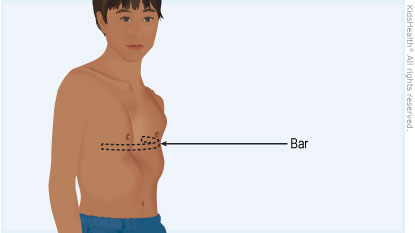Pectus Excavatum: The Nuss Procedure
What Is Pectus Excavatum?
Pectus excavatum is a condition in which the breastbone (sternum) of the chest is caved in. This happens because several ribs and the breastbone grow abnormally. Pectus excavatum may be mild or severe. Severe pectus excavatum may cause problems with the heart and lungs.
What Is the Nuss Procedure?
The Nuss procedure is a surgery to correct severe pectus excavatum. It's considered "minimally invasive" because only a few small incisions (cuts) are needed.
What Happens During the Nuss Procedure?
The Nuss procedure has several steps:
- The surgeon makes two small cuts in the side of the chest.
- The surgeon places one or more steel bars behind the breastbone and attaches them to the outer edge of the ribs. The surgeon uses a tiny camera to get the bars in the right place.
- The surgeon turns the bars, raising the breastbone.
- A metal plate (called a stabilizer), sutures (stitches), or wire is placed to hold the bars in place.

The chest reshapes after about 2–4 years. Then the surgeon removes the bars.
What Happens After the Nuss Procedure?
Even though the Nuss procedure is minimally invasive, your child will need pain medicine and rest after the surgery. He or she will need to stay home from school for about 3 weeks. It may take 6 months or more for your child to return to all activities he or she did before the surgery.
For about 6 weeks after the surgery, your child should:
- Do all breathing exercises (this helps prevent infection).
- Walk or do other gentle exercises as recommended by the surgeon.
- Avoid strenuous activity, including running.
- Not drive.
- Ride in the back seat to avoid possible trauma from an air bag.
Your child should not play sports that could cause a chest injury (such as football, soccer, and baseball) until the surgeon says it's OK.
Check with your surgeon if you have any questions about what activities are safe for your child.
Are There Any Risks From the Nuss Procedure?
There are risks with any surgery, including bleeding, infection, and problems with anesthesia.
Specific risks for the Nuss procedure include:
- pain that can last a month or more
- bars that move out of place
- fluid around the lung or a collapsed lung
- damage to the heart or lungs during surgery
- pectus excavatum that comes back
When Should I Call the Doctor?
Call the doctor if your child has:
- chest pain that's not relieved by pain medicines
- shortness of breath or trouble breathing
- a fever
What Else Should I Know?
Children with pectus carinatum or pectus excavatum can feel self-conscious about the way they look. The Nuss procedure can improve the way the chest looks and help a child's self-esteem. Although the recovery time can be difficult, most kids are happy with the results.
Note: All information is for educational purposes only. For specific medical advice, diagnoses, and treatment, consult your doctor.
© 1995-2024 KidsHealth ® All rights reserved. Images provided by iStock, Getty Images, Corbis, Veer, Science Photo Library, Science Source Images, Shutterstock, and Clipart.com

